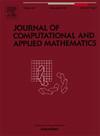有界三维样品的磁化矩:大圆盘上平面测量的渐近恢复
IF 2.6
2区 数学
Q1 MATHEMATICS, APPLIED
Journal of Computational and Applied Mathematics
Pub Date : 2025-09-23
DOI:10.1016/j.cam.2025.117085
引用次数: 0
摘要
反磁化问题是通过测量磁场来推断磁源的信息。与一般的磁化分布不同,源的总磁化(净力矩)是一个理论上可以由场唯一确定的量。同时,对于实际应用(无论是大尺度还是小尺度)来说,它往往是最有用的量,比如在磁勘探问题中检测磁异常,或者找到磁化岩石样品的总体强度和磁化分布的平均方向。众所周知,净力矩分量可以使用所谓的Helbig积分来显式估计,该积分涉及平面上磁场数据对简单多项式的积分。计算这些积分需要了解大区域的磁场数据,或者使用特别的方法来弥补磁场数据的不足。在本文中,我们推导了Helbig积分的高阶类似物,它允许根据较小区域上可用的测量数据估计总磁化分量。在用扫描显微镜分析岩石样品剩余磁化的具体实验装置的激励下,我们还将Helbig积分扩展到只需要一个场分量知识的情况。此外,我们除了推导这些新公式外,还严格证明了它们的准确性。所提出的方法基于傅里叶域中的适当分裂和振荡积分的估计(包括小参数和大参数),阐明了净力矩分量的渐近公式的推导到任意阶,这是一种以前不清楚的可能性。对所得结果进行了数值说明,并讨论了其对噪声的鲁棒性。本文章由计算机程序翻译,如有差异,请以英文原文为准。
Magnetisation moment of a bounded 3D sample: Asymptotic recovery from planar measurements on a large disc
Inverse magnetisation problem consists in inferring information about a magnetic source from measurements of its magnetic field. Unlike a general magnetisation distribution, the total magnetisation (net moment) of the source is a quantity that theoretically can be uniquely determined from the field. At the same time, it is often the most useful quantity for practical applications (on large and small scales) such as detection of a magnetic anomaly in magnetic prospection problem or finding the overall strength and mean direction of the magnetisation distribution of a magnetised rock sample. It is known that the net moment components can be explicitly estimated using the so-called Helbig’s integrals which involve integration of the magnetic field data on the plane against simple polynomials. Evaluation of these integrals requires knowledge of the magnetic field data on a large region or the use of ad hoc methods to compensate for the lack thereof. In this paper, we derive higher-order analogs of Helbig’s integrals which permit estimation of total magnetisation components in terms of measurement data available on a smaller region. Motivated by a concrete experimental setup for analysing remanent magnetisation of rock samples with a scanning microscope, we also extend Helbig’s integrals to the situation when knowledge of only one field component is necessary. Moreover, apart from derivation of these novel formulas, we rigorously prove their accuracy. The presented approach, based on an appropriate splitting in the Fourier domain and estimates of oscillatory integrals (involving both small and large parameters), elucidates the derivation of asymptotic formulas for the net moment components to an arbitrary order, a possibility that was previously unclear. The obtained results are illustrated numerically and their robustness with respect to the noise is discussed.
求助全文
通过发布文献求助,成功后即可免费获取论文全文。
去求助
来源期刊
CiteScore
5.40
自引率
4.20%
发文量
437
审稿时长
3.0 months
期刊介绍:
The Journal of Computational and Applied Mathematics publishes original papers of high scientific value in all areas of computational and applied mathematics. The main interest of the Journal is in papers that describe and analyze new computational techniques for solving scientific or engineering problems. Also the improved analysis, including the effectiveness and applicability, of existing methods and algorithms is of importance. The computational efficiency (e.g. the convergence, stability, accuracy, ...) should be proved and illustrated by nontrivial numerical examples. Papers describing only variants of existing methods, without adding significant new computational properties are not of interest.
The audience consists of: applied mathematicians, numerical analysts, computational scientists and engineers.

 求助内容:
求助内容: 应助结果提醒方式:
应助结果提醒方式:


